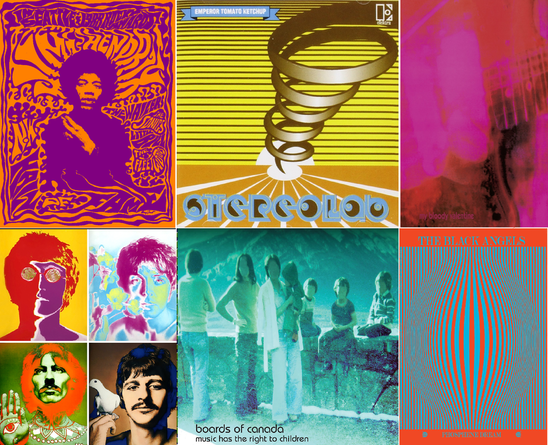|
Written by Mike Barnett After its rise and fall from popularity and a period of obscurity during the late 70-80’s, Psychedelic Music has experienced a rebirth. But Psych 2.0 wouldn’t gain the attention it has if it were only rehashing the past, though. There is innovation. But you can hear very clearly where they’re drawing from. This blog explores the culture and history of Psych music both past and present. The first incarnation of Psychedelic Music came out of the counterculture of the 60’s. Bands (whose t-shirts are now ironically sold at Walmart) like the Beatles, Pink Floyd, Jimi Hendrix, the Grateful Dead, the Byrds, the Doors, the Velvet Underground, and Jefferson Airplane spoke to the outcasts of a generation that questioned societal norms and experimented with new ideas on race, gender, sexuality, and spirituality. Use of psychoactive drugs like LSD, psilocybin mushrooms, and cannabis became widespread, having a large influence on art, music, and culture. Blending rock ‘n’ roll with numerous other styles, the pioneers attempted to recreate the warped reality of the psychedelic experience**. Lyrically, ranging from bizarre fantasy to current politics, it referenced everything from Alice in Wonderland to Richard Nixon to the Tibetan Book of the Dead. It was musically innovative and would influence generations of styles to come while helping to push new technologies for sound manipulation and recording. After its rise and fall from popularity and a period of obscurity during the late 70-80’s, Psychedelic Music experienced a rebirth. The west coast style of the Grateful Dead returned in 90’s bands like Blind Melon ("No Rain"), Blues Traveler and Phish. British style Psychedelia continued with Oasis ("Champagne Supernova"). The Brian Jonestown Massacre had Their Satanic Majesties’ Second Request, an overt reference to the Rolling Stones, the Beatles, and the era as a whole. The Butthole Surfers’ song "Pepper" and Beck’s "Loser" and later "The New Pollution" were undeniably psychedelic and in heavy rotation. However, for many of these artists, it was only one of the many styles they were experimenting with. Lumped into the Alt Rock category, along with Grunge and the likes of Dave Matthews Band, it no longer represented the grand manifesto of youth culture. In the past decade, with bands like the Black Angels, Tame Impala, Dungen, and Temples receiving mass attention and Psych festivals popping up all over America and Europe, Psych has made a bigger, more overt comeback in the 00’s (its name abbreviated to a catchy buzzword). It joins the current celebration of a golden age of art and music along with vintage clothing stores and the revival of vinyl records. Psych 2.0 wouldn’t gain the attention it has if it were only rehashing the past, though. There is innovation. But you can hear very clearly where they’re drawing from. Temples, for example, draws from bands like the Beatles and the Who with "Shelter Song". Songwriting aside, a lot of the original recording techniques, equipment and instruments are adopted. Like hobbyists, many of them record at home with gear from their collections. Vintage guitars, pedals, tube amplifiers, reverb tanks, and reel-to-reel tape machines; It’s the fan in them that needs to hunt down that discontinued microphone or compressor they heard on some old record. When the Black Angels tour they bring their own vintage PA speakers to achieve the specific sound their after. (Check out: "Yellow Elevator #2" by the Black Angels) Beyond its Rock-based identity, psychedelic music comes in many other diverse forms. In the 70’s Jamaican recording engineers made Dub music by remixing Reggae songs with live effects (Roots of Dub by King Tubby). Krautrock of the 70’s used Rock instrumentation but abandoned traditional song structures with bands like Can, Neu!, and Amon Düül II jamming on one part for up to 20 minutes ("Halleluhwah" by Can). In the late 80’s, bands like My Bloody Valentine and Cocteau Twins helped pioneer Shoegaze/Dream Pop (Check out: Loveless by My Bloody Valentine.) More recently, Animal Collective abandons almost all conventions of rock & roll, with lo-fi drum loops, noisy sampling, and very little guitar. But a lot of their vocal style comes straight from the Beach Boys. ("Guys Eyes" by Animal Collective.) Electronic Music artists like Boards of Canada, Black Moth Super Rainbow, and (more recently) Com Truise are undeniably psychedelic ("Dreamsicle Bomb" by Black Moth Super Rainbow). Ambient artists also have a psych side ("New Animals from the Air" by Eluvium). And even Pop can be psych as Stereolab shows with "Hallucinex". There is a whole world of music that sounds psychedelic that doesn’t fall under the genre of Psychedelic Music. Psychedelic Music refers not only to a style of music but to a culture surrounding the music. Psychedelic Music wears its hair long, takes drugs, explores the mind, looks beyond convention; It pairs well with kaleidoscopes, paisley, rose colored glasses, and velvet pants. For some, Psychedelic Music used to indicate an exciting push towards a new future in art and culture. For modern torch bearers, it represents an old dream well worth recreating. **“Psychedelic” refers to the experience of unusual or exaggerated sensory perceptions and heightened awareness brought on by use of psychedelic drugs. More broadly, non-drug induced experiences such as dreaming, meditation, sleep deprivation, sensory deprivation, near death experiences, out of body experiences, and hypnosis can be considered psychedelic..
0 Comments
Leave a Reply. |
Categories
All
Blog Archives
July 2024
|



 RSS Feed
RSS Feed